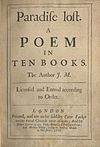Portal:The arts/Featured article/July, 2006
Restoration literature is the literature written in English during the period commonly referred to as the English Restoration (1660 - 1689), corresponding with the last years of the direct Stuart reign in England, Scotland, Wales, and Ireland. In general, the term is used to denote roughly homogeneous styles of literature that center on a celebration of or reaction to the restored court of Charles II. It is a literature that includes extremes, for it encloses both Paradise Lost and the Earl of Rochester's Sodom, the high-spirited sexual comedy of The Country Wife and the moral wisdom of Pilgrim's Progress. It saw Locke's Treatises on Government, the founding of the Royal Society, the experiments and holy meditations of Robert Boyle, the hysterical attacks on theaters from Jeremy Collier, and the pioneering of literary criticism from John Dryden and John Dennis. It saw news become a commodity, the essay develop into a periodical artform, the beginnings of textual criticism, and the emergence of the stock market.
The dates for "Restoration literature" are a matter of convention, and they differ markedly from genre to genre. Thus, the "Restoration" in drama may last until 1700, while in poetry it may last only until 1666 and the annus mirabilis, and in prose it might end in 1688, with the increasing tensions over succession and the corresponding rise in journalism and periodicals or not until 1700, when those periodicals grew more stabilized. In general, the term "Restoration" is used to denote the literature that began and flourished due to Charles II, whether that literature was the laudatory ode that gained a new life with restored aristocracy or the eschatological literature that showed an increasing despair among Puritans, or the literature of rapid communication and trade that followed in the wake of England's mercantile empire.

